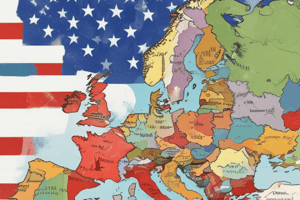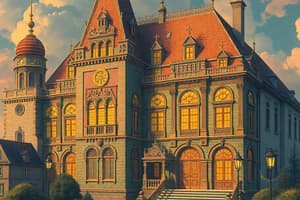Podcast
Questions and Answers
Which of the following was NOT a primary objective of the 1948 Congress of Europe?
Which of the following was NOT a primary objective of the 1948 Congress of Europe?
- Demonstrating public support for European unity.
- Proposing solutions to governments regarding European unity challenges.
- Giving new impetus to the international publicity campaign.
- Establishing a unified European military force. (correct)
How did the Berlin Blockade of 1948 contribute to the formation of NATO in 1949?
How did the Berlin Blockade of 1948 contribute to the formation of NATO in 1949?
- It led to the direct involvement of the United Nations in European defense.
- It highlighted the necessity for a unified Western military alliance to deter Soviet aggression. (correct)
- It improved relations between the Soviet Union and Western countries.
- It demonstrated the effectiveness of existing treaties, negating the need for NATO.
What was the main purpose of the Treaty of Brussels signed in 1948?
What was the main purpose of the Treaty of Brussels signed in 1948?
- To form a common market and eliminate trade barriers.
- To establish economic cooperation between Western and Eastern European countries.
- To create a mutual defense agreement against potential threats, particularly from Germany and the Soviet Union. (correct)
- To promote cultural exchange and understanding among European nations.
Which of the following best describes the significance of the Schuman Declaration of 1950?
Which of the following best describes the significance of the Schuman Declaration of 1950?
What key principle established by the Statute of the Council of Europe signed in 1949 is still relevant today?
What key principle established by the Statute of the Council of Europe signed in 1949 is still relevant today?
Which of the following best describes the primary distinction between the European Economic Community (EEC) and the European Free Trade Association (EFTA) upon their establishment?
Which of the following best describes the primary distinction between the European Economic Community (EEC) and the European Free Trade Association (EFTA) upon their establishment?
What key concept, inspired by the United States, was considered as a way for Europe to achieve stability by nation-states relinquishing some sovereignty?
What key concept, inspired by the United States, was considered as a way for Europe to achieve stability by nation-states relinquishing some sovereignty?
What was the main reason for the French Parliament's rejection of the European Defence Community (EDC) in 1954?
What was the main reason for the French Parliament's rejection of the European Defence Community (EDC) in 1954?
How did the Western European Union (WEU) contribute to European integration during the Cold War?
How did the Western European Union (WEU) contribute to European integration during the Cold War?
Which of the following best describes David Mitrany's functionalism and its intended impact on political unity?
Which of the following best describes David Mitrany's functionalism and its intended impact on political unity?
How did the Organization for European Economic Cooperation (OEEC) contribute to European integration after its establishment in 1948?
How did the Organization for European Economic Cooperation (OEEC) contribute to European integration after its establishment in 1948?
Which issue triggered the Empty Chair Crisis in 1965, and what was the core dispute?
Which issue triggered the Empty Chair Crisis in 1965, and what was the core dispute?
What was the primary objective of the Pan-Europa Movement founded by Richard Coudenhove-Kalergi after World War I?
What was the primary objective of the Pan-Europa Movement founded by Richard Coudenhove-Kalergi after World War I?
What was the Luxembourg Compromise of 1966, and what impact did it have on the Empty Chair Crisis?
What was the Luxembourg Compromise of 1966, and what impact did it have on the Empty Chair Crisis?
What was the significance of the Treaty of Dunkirk, signed in 1947, in the context of European integration?
What was the significance of the Treaty of Dunkirk, signed in 1947, in the context of European integration?
Which of the following best describes the 'Luxembourg Compromise' and its significance in EU decision-making?
Which of the following best describes the 'Luxembourg Compromise' and its significance in EU decision-making?
How did Margaret Thatcher's 1988 speech at the College of Europe influence the future trajectory of the UK's relationship with the EU?
How did Margaret Thatcher's 1988 speech at the College of Europe influence the future trajectory of the UK's relationship with the EU?
What was the primary justification for the UK rebate negotiated by Margaret Thatcher in 1985?
What was the primary justification for the UK rebate negotiated by Margaret Thatcher in 1985?
Which of the following examples best illustrates the 'deepening' of European integration?
Which of the following examples best illustrates the 'deepening' of European integration?
How did the Maastricht Treaty (1993) expand the scope of European integration?
How did the Maastricht Treaty (1993) expand the scope of European integration?
Flashcards
Federalism in Europe
Federalism in Europe
The idea of European nations unifying, similar to how states unite under a federal government, to ensure stability and global influence.
Pan-European Movement (1923)
Pan-European Movement (1923)
A movement founded by Richard Coudenhove-Kalergi advocating for a united Europe to prevent future wars through cooperation among democracies after WWI.
Functionalism (David Mitrany)
Functionalism (David Mitrany)
British political scientist David Mitrany's idea that cooperation in practical areas (trade, infrastructure) leads to cross-border trust and, eventually, lasting peace.
Treaty of Dunkirk (1947)
Treaty of Dunkirk (1947)
Signup and view all the flashcards
OEEC (1948)
OEEC (1948)
Signup and view all the flashcards
Congress of Europe (1948)
Congress of Europe (1948)
Signup and view all the flashcards
Berlin Blockade (1948)
Berlin Blockade (1948)
Signup and view all the flashcards
Treaty of Brussels (1948)
Treaty of Brussels (1948)
Signup and view all the flashcards
NATO (1949)
NATO (1949)
Signup and view all the flashcards
Schuman Declaration (1950)
Schuman Declaration (1950)
Signup and view all the flashcards
Treaty of Rome
Treaty of Rome
Signup and view all the flashcards
EFTA
EFTA
Signup and view all the flashcards
Élysée Treaty of 1963
Élysée Treaty of 1963
Signup and view all the flashcards
Empty Chair Crisis
Empty Chair Crisis
Signup and view all the flashcards
Luxembourg Compromise
Luxembourg Compromise
Signup and view all the flashcards
The UK Rebate
The UK Rebate
Signup and view all the flashcards
Deepening EU Integration
Deepening EU Integration
Signup and view all the flashcards
Widening EU Integration
Widening EU Integration
Signup and view all the flashcards
Maastricht Treaty (1993)
Maastricht Treaty (1993)
Signup and view all the flashcards
Study Notes
- Victor Hugo envisioned seamless travel across Europe, symbolizing unity like within one country.
- The United States was used as a model for federalism, where individual states maintain autonomy while cooperating nationally and continental power, and where European nations wanted the same collective ability for global power.
The Pan-Europa Movement
- Advocated for European federalism to prevent war, envisioning a "United States of Europe" after WWI.
- Founded in 1923 by Richard Coudenhove-Kalergi.
- Emphasized cooperation among democracies as a solution to war and conflict.
Winston Churchill & WWII
- Advocated for European integration to prevent conflict, especially between major powers.
- Advocated for the Treaty of Dunkirk.
- Resistance against Nazi Germany laid the foundation for postwar collaboration.
David Mitrany & Functionalism
- Developed the concept of functionalism promoting political unity through functional areas like trade, infrastructure, and technology.
- Believed practical collaboration fosters cross-border trust, leading to peace.
Post WWII
- 1946: Churchill advocated for a "United States of Europe" in his Zurich University speech.
- 1947: The Treaty of Dunkirk was signed, uniting France and Britain against threats.
- 1948: The Organization for European Economic Cooperation (OEEC) was established.
- The OEEC coordinated U.S. financial aid under the Marshall Plan, stimulating cooperation and laying groundwork for economic integration.
- 1948: The Congress of Europe in The Hague was considered a federalist congress, chaired by Winston Churchill.
- Advocated federalism and visioned a unified, cooperative future for European integration.
Congress of Europe Objectives
- To demonstrate public support for European unity.
- To discuss challenges and propose solutions for European unity.
- To give new impetus to the international publicity campaign.
- Suggested institutions: European Centre for Culture, College of Europe, Council of Europe, and European Convention on Human Rights.
Berlin Blockade
- 1948: The Soviet Union blockaded West Berlin, emphasizing the need for a united Western response (later becoming NATO).
Treaty of Brussels & NATO
- 1948: The Treaty of Brussels was signed as mutual defense agreement among Belgium, the Netherlands, Luxembourg, France, and the UK.
- The BeNeLux nations joined the Treaty of Dunkirk and the Treaty evolved into the Western European Union after 1954, emphasizing collective security.
- 1949: The North Atlantic Treaty Organization (NATO) was signed.
- NATO aimed to deter Soviet expansion and ensure Western Europe's defense through mutual commitments and strategic planning.
- 1949: The Statute of the Council of Europe was signed
- The Statute of the Council of Europe established a framework for cooperation in human rights and democracy.
- This led to the European Court of Human Rights (ECtHR) under the European Convention on Human Rights.
Founding the European Communities
- 1950: May 9, Schuman Declaration: Pooling coal and steel production under a supranational authority to prevent war.
- Designed to materially make war between France and Germany impossible by integrating their economies.
- 1951: Treaty of Paris established the European Coal and Steel Community (ECSC).
- Member states of the ECSC: France, West-Germany, Italy, the Netherlands, Belgium and Luxembourg.
- 1952: European Defense Community (EDC) signed. The EDC aimed to create a pan-European military force under supranational control to counter Soviet aggression and prevent conflict.
- 1954: The EDC was rejected by the French Parliament due to concerns over national sovereignty and German rearmament.
- 1953 Draft treaty for a European Political Community (EPC) was adopted Linked to the EDC; when this failed, so did EPC.
- 1954: The Western European Union (WEU) was established.
- WEU coordinated European defense and security policies among member states, bridging gaps between NATO and European integration efforts during the Cold War.
- 1955: Western German accession occurred to NATO.
- 1957: The Treaty of Rome created the European Economic Community (EEC) and the European Atomic Energy Community (Euratom) in 1958.
- Founding nations of the EEC: France, West Germany, Italy, Belgium, the Netherlands, and Luxembourg.
- The treaty marked a shift towards economic integration.
Free Trade
- 1959: The European Free Trade Association (EFTA) was established. This was formed by Austria, Denmark, Norway, Portugal, Sweden, Switzerland and the UK.
- EEC versus EFTA became the inner Six against the outer seven.
- EFTA focused solely on free trade without the deeper political integration of the EEC, creating a divide.
- Differing visions of European cooperation arose where the EEC’s vision was economic and political union, versus the emphasis of EFTA's on economic collaboration only.
Years of crisis
- 1963: 22 January, The Elysée Treaty was signed.
- The Elysée Treaty signified Franco-German friendship.
- The Elysée Treaty was a message of reconciliation.
- The Elysée Treaty created groundwork for bilateral cooperation to support European integration.
- 22 January 2019: The Aachen treaty was signed by France & Germany – renewing the message of reconciliation & strengthening bilateral cooperation.
- 1963: Membership applications of the UK, Denmark, Ireland and Norway
- Du Gaulle rejected the UK twice due to fears that British accession undermined European integration.
- Norway voted against joining in a referendum in 1972.
- 1965: The Empty Chair Crisis began, lasting 7 months.
Common Agricultural Policy
- A proposal was drawn up for financing the Common Agricultural Policy (CAP) – it suggested majority voting in the Council of Ministers. French President De Gaulle disagreed, believing it threatened national sovereignty.
- On July 1, 1965, France began boycotting the Council of Ministers, effectively halting EU decision-making.
- 1966: The Luxembourg Compromise ended the Empty Chair Crisis.
- Luxembourgish Prime Minister Werner proposed the compromise, which was agreed in January 1966.
- The Luxembourg Compromise resolved decision-making conflicts in the EU by allowing member states to veto proposals that threatened its vital national interests.
- 1973: The first enlargement of the EU occurred with the UK, Denmark, and Ireland joining.
- 1975: The first British referendum on EU membership occurred. 67% voted to remain, 33% to exit.
- 1981: Thatcher's speech at the College of Europe on Britain and Europe
- Thatcher emphasized Britain's commitment to European cooperation, but rejected centralized power in Brussels.
UK Rebates
- 1985: The UK Rebate
- Financial mechanism negotiated by Margaret Thatcher to reduce British contributions to the EU budget.
- This was due to the UK's relatively low return from EU agricultural subsidies compared to its contributions.
Widening & Deepening Integration
- Deepening is the intensification of integration processes and structures.
- Widening refers to the enlargement of the EU and expanding scope of competences.
- 1985: The European Council agreed to establish a Single Market.
- 1986: The Single European Act was signed and entered into force by July 1987. It created a single market and a treaty basis for European Political Cooperation (EPC).
- 1992: The Single Market was established.
- 1993: The Maastricht Treaty established the European Union signed in 1992, and entered into force in 1993.
- Goals: To expand the scope of European Integration; To reform the EC's institutions and decision-making procedures; To bring about the European Monetary Union (EMU)
- Initiated cooperation on Common Foreign and Security Policy (CFSP) and Justice and Home Affairs (JHA).
Three Pillars
- European Communities
- Common Foreign and Security Policy
- Justice and Home Affairs
- 1997: The Amsterdam Treaty was signed and entered into force in May 1999.
- The Amsterdam Treaty added the establishment of an area of freedom, security and justice (AFSJ) to the EU's objectives, changing Pillar III: Much of Justice and Home Affairs activity was shifted from Pillar III into Pilar.
Schenegen Agreement
- Schengen cooperation was incorporated into the EU, however the UK, Ireland, and Denmark gained several opt-outs.
- 1999: Stage III of the Economic and Monetary Union (EMU).
- 2002: Introduction of the euro.
- 2001: The Treaty of Nice aimed to reform the institutional structure of the EU to withstand the challenges of enlargement.
Weighted Voting
- Introduced weighted voting in the Council.
- Seats in the European Parliament increased from 700 to 732.
- The powers of the EP were increased.
- 2001-2004: The Future of Europe debate launched.
- 2004: The Treaty establishing a Constitution for Europe was signed.
- 2007: Lisbon Treaty was signed.
- 2005: France & Netherlands opposed the EU in referendums.
- Lisbon Treaty: signed 2007, entered into force December 2009
- Lisbon Treaty Altered the Treaty on the European Union.
- Altered and renamed the Treaty establishing the European Community into the Treaty on the Functioning of the European Union (TFEU).
- Included clauses President of the EU but used High Representative instead of Foreign Minister.
Wider Integration
- Original six: France, Germany, Italy, Belgium, the Netherlands, Luxemburg
- 1973: First enlargement: UK, Ireland (neutral), Denmark (Norway) – being the first group of members to access from the European Free Trade Association.
- 1981: Second enlargement: Greece (crisis).
- 1987: Third: Mediterranean accession: Spain and Portugal
- 1995: Fourth enlargement: Austria, Finland, and Sweden; as the second group of members to access from the European Free Trade Association.
- 2004: Fifth enlargement: Cyprus, Czech Republic, Estonia, Hungary, Latvia, Lithuania, Malta, Poland, Slovakia, Slovenian.
- 2007: Bulgaria and Romania joined.
- 2013: Croatia joined.
- Accession by a new group of members is followed by a new treaty foreseeing deeper integration.
Modes of Co-operation
- Schengen with Iceland, Lichtenstein, Norway, Switzerland
- EEA with Iceland, Lichtenstein, Norway
- Custom Union with Turkey
Candidate Countries
- Candidate countries: Albania, the Republic of North Macedonia, Montenegro, Serbia and Turkey, Ukraine & Moldova.
- Potential candidates: Bosnia and Herzegovina, Kosovo, Georgia
Brexit & Other EU Issues
- Brexit: The UK's departure removed a nuclear power and a UN Security Council seat from the EU.
- Eurozone Crisis 2008: Continued financial instability affected several member states.
- Migration Crisis 2015: Strains on EU cohesion as responses to migration differed among member states.
- COVID-19 Pandemic: Severe health and economic challenges arose for the EU.
- Calls arose for for a European army and reassessment of NATO's role in regional security.
Studying That Suits You
Use AI to generate personalized quizzes and flashcards to suit your learning preferences.




